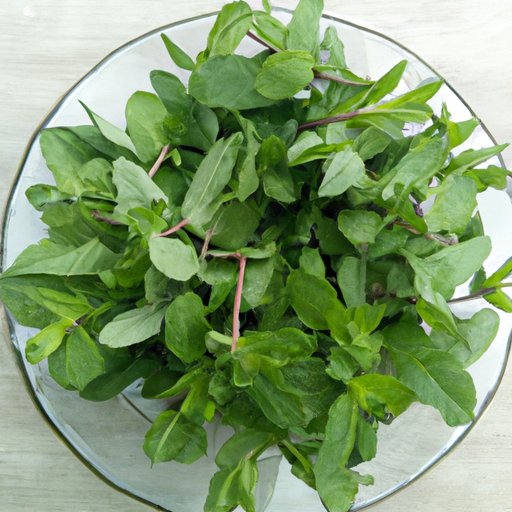
I. Introduction
Have you ever wondered if it’s safe to eat mint leaves? Many people are unsure about the uses and benefits of mint in cooking and daily life. This article explores the nutritional benefits, creative recipes, and medicinal purposes of mint. Let’s dive in and learn more about how you can incorporate this versatile herb into your routine.
II. The Health Benefits of Eating Mint Leaves: What You Need to Know
Mint leaves contain vitamins A and C, calcium, and potassium. This blend of vitamins makes it a great addition to your diet. According to research, mint also has anti-inflammatory and antioxidant properties that can benefit your body. Mint is also known to have a calming effect on the body’s muscles, which can be helpful in relieving nausea and cramping.
Though mint has many benefits, it’s not suitable for everyone. Mint can cause heartburn and worsen reflux symptoms in some people. Mint can also cause allergy symptoms in some people. However, in most cases, it is safe to eat fresh mint as a garnish or as a key ingredient in a recipe.
It’s easy to incorporate mint into your meals. Mint can be a refreshing addition to salads and smoothies. Mint can also add flavor to savory dishes such as curries and stews. Fresh mint is a versatile herb, and it’s easy to add to your sitting diet in creative ways.
III. Cooking with Mint: Creative Recipes to Try Today
Mint leaves can be used to create many delicious recipes. Want to try something sweet and refreshing? Add some fresh mint leaves to your favorite homemade ice cream recipe. For a summertime treat, try making a watermelon salad with fresh mint leaves, feta cheese, and a balsamic glaze.
If you’re looking for new seasoning ideas, try dried mint. Dried mint is highly concentrated and can add an intense, refreshing flavor to your meals. Mix dried mint into marinades for grilled meats or vegetables. Alternatively, sprinkle dried mint over roasted root vegetables for a refreshing twist on a classic side dish.
IV. Mint Leaves vs. Peppermint: What’s the Difference?
Many people confuse mint leaves and peppermint plants, but these two herbs have different flavor profiles and uses. Mint leaves have a mild, sweet taste and can be used in both sweet and savory dishes. Peppermint is a more potent herb with a strong, cool flavor. Peppermint is commonly used in candy, toothpaste, and gum because of its refreshing aroma and flavor.
Mint and peppermint can both be used in cooking and for medicinal purposes. Mint is often used in herbal remedies to soothe digestive issues. Peppermint is often used in natural remedies for headaches and nausea. Both herbs have unique flavors and benefits, making them worthwhile additions to your herb garden or spice rack.
V. Mint Tea: A Soothing and Refreshing Beverage
Mint tea is a popular beverage worldwide and is known for its refreshing taste and calming properties. Mint tea can soothe digestive issues, fight bad breath, and calm the mind and body. Preparing mint tea is easy and only requires a handful of ingredients. To make a cup of fresh mint tea, steep a few leaves in hot water for 5-10 minutes. Add honey or lemon juice to taste.
If you want to add a twist to your mint tea, try adding other herbs or spices such as ginger or lavender. These additions can create a unique flavor profile and provide additional health benefits.
VI. DIY Infused Oils: Using Mint Leaves to Elevate Your Cooking Game
Infused oils are mixtures of oil and herbs or spices. Infused oils can be used to add flavor to pasta, seafood, and vegetables. To make mint-infused oil, combine fresh mint leaves and olive oil in a jar. Let the mixture sit for a week to allow the flavors to meld together. Strain the mixture and use the oil to add flavor to your favorite dishes.
Mint-infused oil can add a unique twist to classic recipes like pesto or roasted potatoes. For a refreshing twist on a creamy pasta dish, add a drizzle of mint-infused oil over your noodles. The possibilities are endless, and customized infused oils are a great way to elevate your cooking game.
VII. Conclusion
In conclusion, mint leaves are a versatile and nutritious herb that can be used in a variety of ways in cooking and for medicinal purposes. Mint leaves provide many health benefits, including aiding digestion, reducing inflammation, and providing antioxidant properties. Mint leaves can be used fresh or dried and can be utilized in a variety of creative recipes and infused oils. I hope this article has helped to educate you on the many benefits of incorporating mint leaves into your life.




